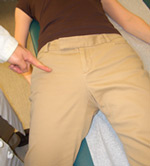Description
Snapping hip is a condition in which a patient notices a feeling of catching or snapping with hip motion. The feeling may come with a noise and/or pain. Sometimes it may even be a sensation of the hip “giving way” or “coming out of socket.”
Types of Snapping Hip
Snapping is caused by different soft tissue structures around the hip. It is
not the hip coming in and out of the socket.
- Hip flexor tendon (psoas) - this tendon lives in the front of the hip or groin and can snap over the front of the pelvis bone. The hip flexor tends to snap when the hip is moved from a bent to straight position. It can be caused by a tight or inflamed hip flexor tendon. This is called internal snapping hip.
- Iliotibial band (IT band) - this is a large band of tissue that runs down the side of the leg and can snap over a bump on the femur called the greater trochanter. Pain is usually located over the bone on the side of hip. This snapping or popping can occur when walking. Sometimes because the snap or pop is so big that it can be seen when looking at the hip. Often patients will describe this feeling like their hip is coming out of the socket. Causes include a tight IT band, weak hip muscles, or a combination of the two. This is called external snapping hip.
- Hamstrings (behind the hip) - this is less common but can occur.
- Hip joint - sometimes catching in the hip can be caused by problems within the hip joint, such as a tear of the labrum (cartilage around the hip socket).
Symptoms
Symptoms include a feeling of catching, snapping, giving way, or “coming out of socket.” Sometimes there is a noise that accompanies the feeling. Pain may or may not be present. Symptoms may worsen with activity and may decrease with rest. It is unusual that a snapping hip results in inability to participate in sports and activities, but this can happen.
Examination

Psoas Stress Test - finger points to hip flexor that may be painful or snapping
our doctor will move your hip in all directions and palpate (feel) the areas of soft tissue around your hip. Your doctor may be able to reproduce your symptoms by moving your hip around, and they may also ask you if you can make your hip snap for them. Your doctor will test your hip flexor and IT band for tightness (flexibility) and also check for weakness around the hip.
XRays and Tests
X-rays usually do not show the reason for snapping hips, but your doctor may order these to be sure not to miss other problems in the bones or joint.
MRI scan is very rarely necessary to sort out the issue of hip snapping. Your doctor may order one if they are concerned that your pain is coming from something else, such as a cartilage tear or joint problem.
Treatment
Treatment for snapping hip depends on how much pain you are having. Options can range from rest from strenuous activity to physical therapy. If the pain is mild, than often your doctor can instruct you on some stretching and exercises to begin at home. If the snapping is not painful, reassurance and explanation may be the most important things your doctor can provide. It is helpful to know that it is not the hip moving in and out of the socket. Hip dislocation is very rare and generally requires significant force such as a car accident.
It is very rare to require any procedures for snapping hip but in certain cases there can be a role for injections or even surgery.
Examples of stretches include runners lunge for the hip flexor tendon in the front of the hip and figure 4 stretch for the IT band on the outside of the hip. For more flexible patients, such as dancers and gymnasts, pigeon pose in yoga can be good for stretching both areas.

Hip Flexor Stretch

Pigeon Pose
Outcomes
The actual hip snapping may not entirely go away, but if there is pain or discomfort that goes along with the snapping, most patients feel relief after rest, physical therapy, and a home exercise program.
More Information
Condition QR Code:


 POSNA.org
POSNA.org



